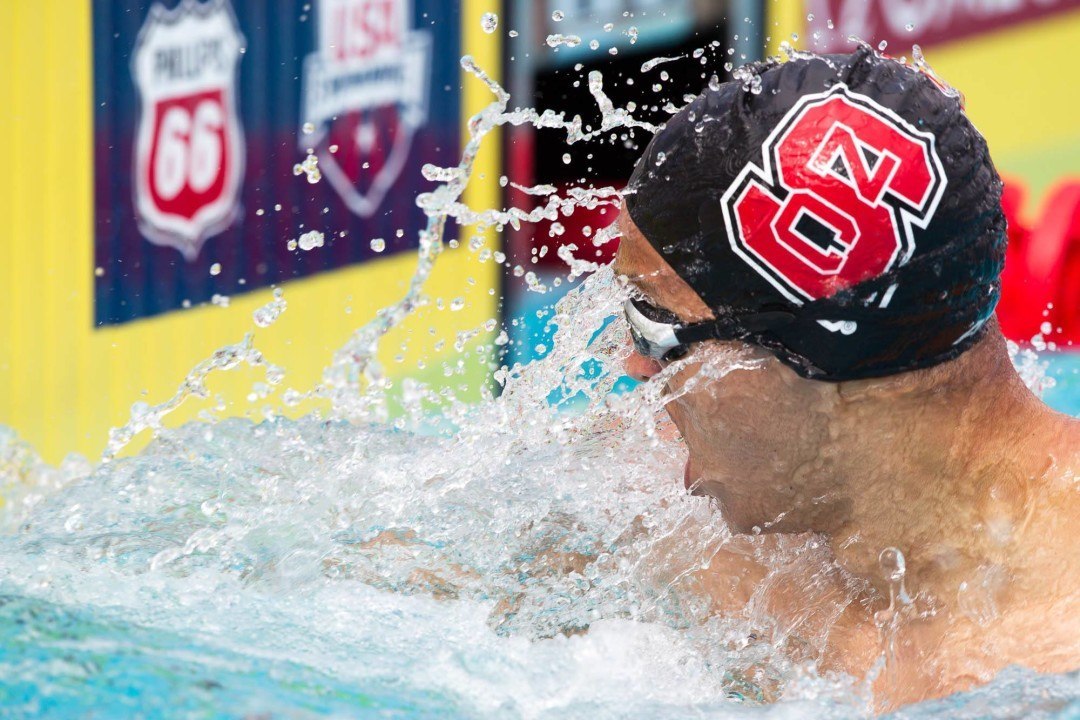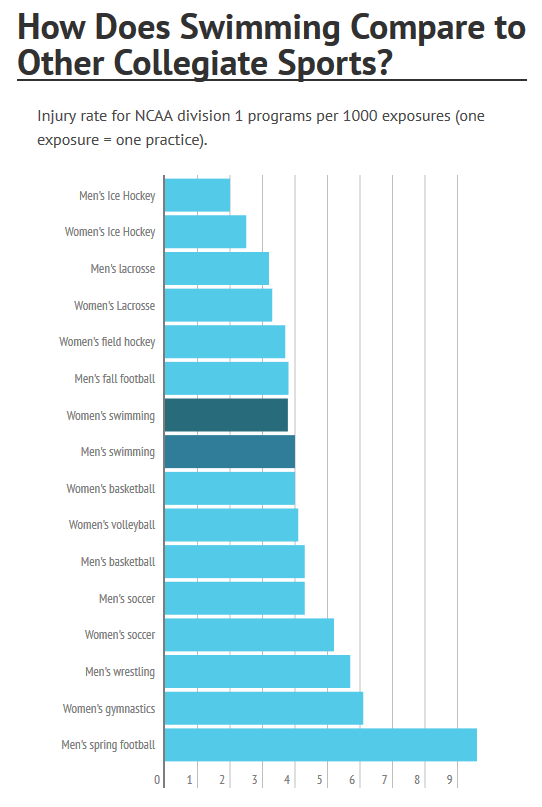This post originally appeared over at YourSwimBook.com. Join Olivier’s weekly motivational newsletter for swimmers by clicking here.
Swimmers pride themselves on having legendary work ethics. We take satisfaction in knowing that our workload—even as young athletes—far exceeds that which is typical of other major sports.
From the early morning workouts, to the punishing weeks of training during the holidays, and the towering number of meters and yards swum over the course of our training we work hard.
So hard, in fact, that it would seem to make sense that swimmers get injured a whole lot.
As someone who spent a majority of time during my later teenage years sidelined with chronic shoulder injuries I know that swimming can be a cause of infuriating, serious, and painful injury.
But personal experience aside, do swimmers in general get injured more often than other athletes?
Injury Rates for Swimmers
There is no shortage of research on injury in sport, and swimming is no exception. Although the numbers vary with the studies outlined below, you can get a broad sense of how often injury happens in the water.
An Australian study followed 5 different clubs over a 12 month period, with 74 swimmers participating in a self-reported study.
38% of swimmers reported missing training at one point or another due to shoulder injury. 22% had injuries that lasted longer than two weeks. Injury rates ranged from 0.2 to 0.3 per 1000 km.

While an injury rate of 0.2 to 0.3 may seem low, the study notes:
“…a squad of 20 swimmers that trains 50km each week may sustain five SIP [injuries causing missed training time] and three SSI events [injuries causing pain lasting longer than two weeks] during a 16-week training phase.”
No matter how you dice it up those injuries can cause some serious havoc on a team’s program.
A separate study done with over 265 Danish swimmers found an injury rate of 0.9% per 1,000 hours of swimming. The shoulder led the way, with the back also commonly cited. Breaststrokers were much more likely to have knee injuries, and the fastest swimmers in the study experienced injury significantly more often (added training, perhaps?).
How Do Swimmers Get Injured?
It should probably come as little to no surprise that the shoulders lead the way when it comes to which body parts are injured when it comes to swimming.
In a study done with the University of Iowa men’s and women’s team (cited later), five years of monitoring found swimmers were most likely to get injured in the following ways:
- 60% of injuries happen in the water.
- 30-40% doing dryland.
- Body Part Most Injured in the water: Shoulder.
- Body Part Most Injured doing Dryland: Back/neck.
While breaststrokers didn’t suffer as much in the shoulder department, they were certainly not immune to injury with increased injuries in the knee and hip areas:
- 86% of breaststrokers experienced knee pain.
- 47% of breaststrokers experienced knee pain weekly.
- 42% of breaststrokers missed training time due to groin injuries.
How Often Do Swimmers Get Injured Compared to Other Athletes?
Okay, so common sense and personal experience tells us that swimming carries an increased risk of suffering shoulder, neck/back and knee injury.
(Not too mention stubbed fingers, paddle slaps and so on, but that is for a different time.)
Chronicling five years of training history for an NCAA division 1 program at the University of Iowa researchers found the following injury rates for collegiate swimmers:
- 4.00 injuries per 1000 exposures for men (exposure counts as a practice or competition)
- 3.78 injuries per 1000 exposures for women
These stats can be misleading given that it only tracked one program—and their individualized approach to training isn’t necessarily a blanket generalization for all swim teams and programs—over a 5 year period.
That being said, it provides us with a number to measure up against other sports.
Below is where swimming falls when compared to other NCAA division 1 sports averaged out over a 15 year period.
Keep in mind that these are also the practice injury rates, and not the game injury rates, which were significantly higher with football leading the way with 35.9 injuries per 1000 exposures, and women’s softball at the bottom of the pile at 4.3 injuries per 1,000.
 In Summary
In Summary
In terms of swimming being a worse offender for promoting injury than other sports, that doesn’t look like it is the case.
And to be honest, the injury rates for swimmers could and should be able to be dramatically reduced.
After all, we only have our own performance to worry about, we don’t have have people trying to mow us over as in football, or someone else’s ankle to roll over in basketball, or a landing to try and stick from height as in gymnastics.
(Although we do have to tend with the breaststroker’s foot from the next lane, smashing into the lane rope, and so on, but really…)
With a good background of pre-hab, having good posture both in and out of the water, and swimming with proper technique consistently and especially during times of difficult training, swimmers should be able to avoid the injury bug.
Further Reading
For more information on swimmer’s shoulder and swimming injuries, check out some of the following resources:
How to Prevent Swimmer’s Shoulder. A guide we put together recently featuring biomechanists, therapists and chiropractors, and even a space scientist (seriously). Everything you need to know about avoiding swimmer’s shoulder.
The 1 Thing Every College Freshman Swimmer Needs to Know. First year swimmers at university are much more likely to be injured over the course of the season than their teammates. This post discusses why, and outlines some solutions for preparing for that freshman year.
The Psychological Toll of Being Injured All of the Time. When injury does happen, the resulting fallout is more than just physical. Feelings of frustration, anger and even depression are common in athletes struggling to get past injury. Here are some ideas for how to make it through your time on the sidelines.
Dominate the Competition.
 YourSwimBook is a log book and goal setting guide designed specifically for competitive swimmers. It includes a ten month log book, comprehensive goal setting section, monthly evaluations to be filled out with your coach, and more.
YourSwimBook is a log book and goal setting guide designed specifically for competitive swimmers. It includes a ten month log book, comprehensive goal setting section, monthly evaluations to be filled out with your coach, and more.
Learn 8 more reasons why this tool kicks butt now.
Join the YourSwimBook weekly newsletter and get motivational tips and more straight to your inbox. Sign up for free here.

 In Summary
In Summary
I agree with this article a little bit as swimmers do have more injuries than some athletes but the more physical sports are the ones with the most injuries. Me being a swimmer myself I had only one injury in seven years of swimming and it wasn’t that bad. This article puts me at a so-so feeling.
A couple thoughts to add. Swimming injuries do tend to be minor compared to those in other sports. Some shoulder pain caused my improper technique is nowhere near as serious as a concussion, broken bone, etc. This article did a good job explaining that these rates on injuries really should be brought down, because most are preventable. Granted, there will always be the severe injuries not caused by improper form, and these injuries should be the ones shown in the statistics.
I refused to read this article due to the title, after playing varsity football for many years then going on to swim division 1 college, I know for a fact swimming does not have the most injuries, for all I know this article is about the few injuries caused by swimming, let’s be honest, compare the average nfl quarterback against the average pro swimmer.
Yeah, maybe you should have read the article…
Many people buy into the lie that swimming has reduced injuries compared to other sports.